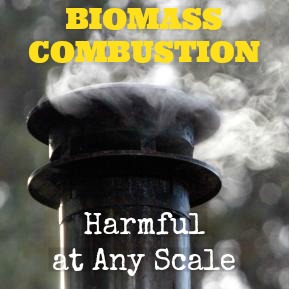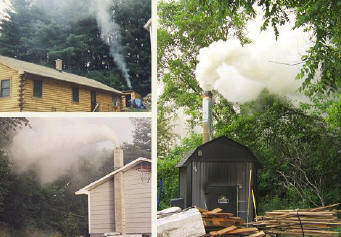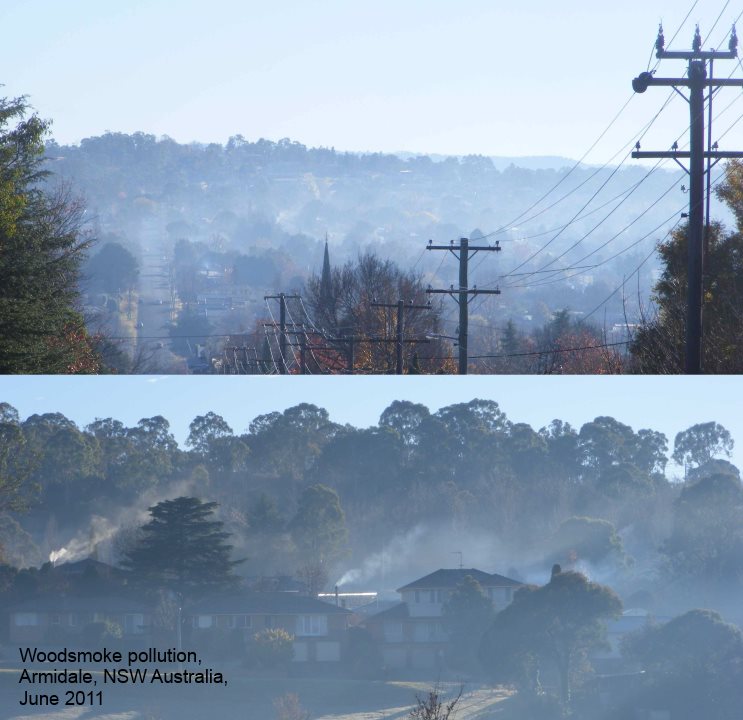Biomass Combustion: Harmful at Any Scale
(June 2014 - Vol. 5, issue 3)
Biomass Combustion: Harmful at Any Scale
- by Cathy Baiton, Only Clean Air
In the same way that industrial biomass combustion can seriously jeopardize public health and the environment in communities, residential and smaller-scale commercial biomass burning also have adverse impacts on health and air quality in neighborhoods.
In many cities and towns, increased wood burning, both indoor and outdoor, has become a potentially year-round source of urban and semi-rural air pollution, whether from highly polluting outdoor wood boilers, needless “recreational” outdoor burning in warmer seasons, or avoidable fireplace or wood stove smoke in cooler months.
Residential smokestacks have even fewer pollution controls than industrial technologies, and people are exposed so directly in the confines of an urban neighborhood, where smoke particles can be trapped between trees, buildings, and other structures and can seep easily into nearby houses, even through closed windows and doors. Studies have found that as much as 70 percent of outdoor smoke pollution can enter surrounding homes, posing health risks to neighbors. Indoors, particle concentrations can build to levels that are dangerously high.

Julie Bamonte Burgo, a clean air activist in Pittsburgh, Pennsylvania, notes that, “In Allegheny County, wood burning smoke accounts for one third of our citizens’ pollution complaints,” and points to the great need in her own and other areas for an ongoing campaign aimed at increased public awareness of the health effects of wood smoke, and of its link to higher rates of heart attacks, strokes, asthma and other lung diseases, hospital admissions, and even early deaths. Julie recalls how at one time her family’s home, due to neighborhood smoke pollution, “was like a gas chamber, it was so bad; even with all the plastic on the doors and purifiers running . . . the smoke would just build up in our house.”
While infants, children, expectant mothers, the elderly, or people with allergies, asthma, or other health concerns are at a special risk to even low levels of neighborhood wood smoke, no amount of smoke exposure can be considered safe for anyone. The ability of even healthy people to safely enjoy outdoor activity is also limited by the presence of any smoke pollution. In fact, the World Health Organization’s International Agency forResearch on Cancer (IARC) now classifies particulate matter in outdoor air pollution as a Group 1 human carcinogen - placing PM in the same category as other cancer-causing agents like asbestos and tobacco smoke.
READ MORE
A Victim of Woodsmoke Pollution
- by Shirley Brandie, WoodBurnerSmoke.net
In 2000, we bought a home to enjoy our retirement in. It was perfect for us! Everything on one floor, a surrounding deck, and a large expanse of lawn. Little did we know that, in 2002, our lives would be changed dramatically! Beginning in 2002, our home became surrounded and infiltrated by wood smoke from our neighbour. There was no help in getting this smoke stopped. Everywhere we turned we received sympathy but were told there was nothing they could do.
We were told that it was an issue to be dealt with at the municipal level. Approaching the municipality and asking for help gave us more sympathy but no action. The people we talked with said it was a “civil matter.” We called the Building Inspector repeatedly about the height of the chimney and were told it met code.
We spoke, both in person and by telephone, to the neighbours telling them that the smoke was getting into our house and making life almost unbearable. The response was to “keep your windows closed.” We tried to explain that the smoke gets in through the furnace intake, spaces under doors, etc. They then said they would not stop burning, would burn what they want and to sue them if we didn’t like it… which we finally ended up doing.
READ MORE

Dirty Wood Heaters
- by Dr. Dorothy Robinson, Woodsmoke.3sc.net
The most health-hazardous air pollutant is PM2.5 (tiny particles less than 2.5 millionth of a metre in diameter) that cause 10 to 20 times as many premature deaths as the next worst pollutant (ozone).
PM2.5 penetrate the deepest recesses of our lungs. As well as causing lung disease, PM2.5 can enter the bloodstream and transport the toxins in air pollution all round the body, causing inflammation, heart disease, cancers, dementia, genetic damage in babies, increased risk of childhood asthma, autism, reduced IQ when children start school and attention problems.
READ MORE

Burn it Up?
- by Vic Steblin
Humans have been burning for much of history. Africa burns its savanna annually and the smoke can be seen from space. Australia and Mediterranean areas regularly burn off hazardous undergrowth. Logging companies burn off residue according to professional forestry codes. Ranchers and farmers burn old grass and crops to release nutrients.
Even lightning by nature burns whole forests. Humans, following nature’s example, seem to love burning. Spring bonfires are used to clear up old branches and yard waste. The burner barrel handled household garbage until too much smoke was produced by too many people. Wood burners still display their historical right to burn anywhere and anytime they please.
Times and conditions change, however, and humans everywhere must reconsider historical traditions for a cleaner modern society. We must leave some old things behind, educate ourselves with modern technology and use resources better. We should stop burning things up.